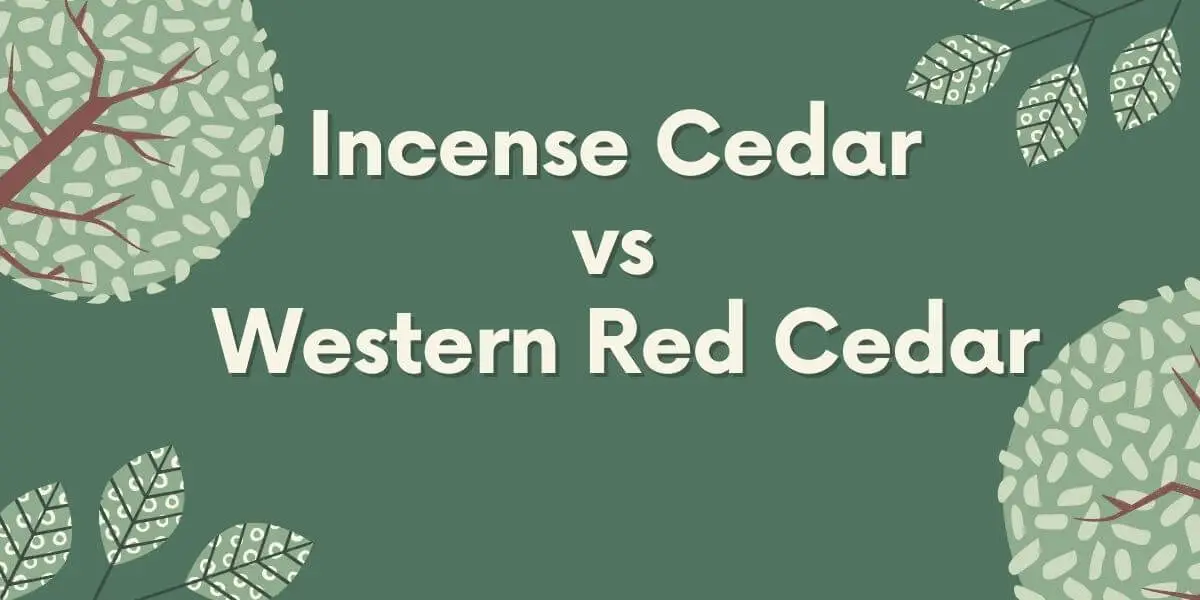Incense Cedar wood is harder and more durable than Western red cedar. The main difference in this is also the color. Western Red Cedar is dark, while Incense Cedar is light in color. Incense cedar and western red cedar are popular cedar species.
What is Incense Cedar?
Incense cedar is a conifer species native to western North America. It is also called white cedar. Incense is a slow-growing tree, so it takes time to become a tall conical tree. The height of its tree ranges from 40 to 60 meters. Incense cedar has dark red/brown bark with dark green leaves. It also gives yellow flowers once a year.
Incense-cedar has a straight grain and medium to a fine uniform texture. So, it is ideal for siding, chests, and various exterior furniture applications.
What is Western Red Cedar?
Western red cedar, also called Western Arborvitae, is native to the Pacific coast of North America. Its tree is pyramid-shaped, and its length varies from 50 to 60 m. It has a straight grain and a fine texture.
Western Red Cedar has excellent rot-resistant properties, making it an ideal choice for external applications. Its durability ensures a long-lasting and low-maintenance solution.
| # | Incense Cedar | Western Red Cedar |
| Scientific name: | Calocedrus decurrens | Thuja plicata |
| Tree Size: | 40–60 m (130–195 ft), 3–5 ft (1–1.5 m) trunk diameter. | 50-60 m (165-200 ft) tall, 7-13 ft (2-4 m) trunk diameter. |
| Janka Hardness: | 470 lbf (2,090 N) | 350 lbf (1,560 N) |
| Color: | Light to medium reddish-brown. | Reddish to pinkish brown. |
| Workability: | Easy to work. | Easy to work. |
| Rot Resistance: | Good rot resistance. | Good rot resistance. |
| Prices: | It is less expensive compared to Western Red Cedar. | It is more expensive compared to Incense Cedar. |
| Uses: | Pencils, Venetian blinds, fence posts, and many more | Shingles, exterior siding, lumber, and many more. |
Uses : Incense Cedar vs Western Red Cedar
Incense Cedar Wood Uses
It is used to make Venetian blinds, fence posts, construction lumber, sheathing, siding, and chests. It is mostly used for making pencils because it is light and soft. Incense Cedar is easy to cut and curve, so it is an ideal choice for making small wooden objects.
Western Red Cedar Uses
Western Red cedar has strongly aromatic and natural rot resistance properties, so it is primarily used to make clothes storage. It is a strong and highly durable wood species. So it’s the most suitable wood to make shingles, exterior siding and lumber, boatbuilding, boxes, crates, and musical instruments.
Appearance and Color: Incense Cedar vs Western Red Cedar
Incense-cedar and western red cedar differ in color between heartwood and sapwood. Sapwood is the outer layer of wood of trees and heartwood is the center part of the wood tree.
Incense Cedar Color
The heartwood color of incense is light to medium reddish-brown and the color of sapwood is light tan to off-white.
Western Red Cedar Color
The heartwood color of western red cedar is reddish to pinkish-brown and the color of sapwood is pale yellowish-white.
Which One is Harder?
Incense Cedar wood is harder and heavier than Western Red Cedar wood. Western Red Cedar has a Janka hardness value of 350 lbf (1,560 N), and dry wood weighs 23 lbs/ft3 (370 kg/m3).
Incense cedar, on the other hand, has a Janka hardness value of 470 lbf (2,090 N), and its dried weight is 24 lbs/ft3 (385 kg/m3).
Workability: Incense-Cedar vs Western Red Cedar
Workability can vary between Incense Cedar and Western Red Cedar, and it depends on several factors such as density, grain structure, and resin content. Here’s a general comparison:
Incense Cedar:
- Workability: Incense Cedar is known for its excellent workability. It has a relatively fine and straight grain, making it easy to work with both hand and machine tools.
- Texture: The wood has a uniform and fine texture.
- Stability: Incense Cedar is stable and tends to resist warping and shrinking, making it suitable for various woodworking applications.
Western Red Cedar:
- Workability: Western Red Cedar is also known for being easy to work with. It has a straight, even grain that allows for clean cuts and smooth finishes.
- Texture: The wood has a coarse texture with a straight grain.
- Stability: Western Red Cedar is dimensionally stable and resistant to warping and checking. It is also lightweight, which contributes to its ease of handling.


Comments are closed.